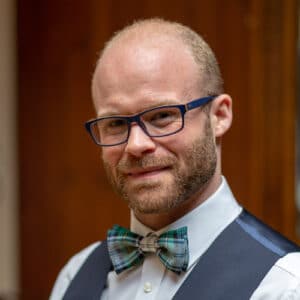Faith-Based Enrollment Marketing: Strategies That Reflect Your Mission
Discover faith-based enrollment marketing strategies that align with your mission and attract students who thrive in your Christian college environment.
Featured
Audience-first marketing goes well beyond crafting content your audience will love.
Being audience-first also determines the channels you use to reach your audience and the frequency of your publications.
It’s also an obsession on how your audience reacts to your messaging.
Did it reach them? Do you have traffic bringing eyes to your content?
Higher ed marketing teams often tout content as an asset, but is the content falling on deaf ears?
Content that isn’t reaching your audience or making any sort of noise is not of much use to you as a marketer.
Without a consistent pipeline for their content, creators will suffer depreciating value in what is truly their most significant asset: their target audience.
 Kyle Campbell, Founder and Managing Director of Education Marketer, believes audience-first marketing can revolutionize how students discover colleges and universities in a creator economy.
Kyle Campbell, Founder and Managing Director of Education Marketer, believes audience-first marketing can revolutionize how students discover colleges and universities in a creator economy.
By scaling content with the appropriate communities, higher ed marketers can establish their authority through authentic relationships.
There are massive changes coming to education marketing in the not-too-distant future.
Search engine marketing, Pay Per Click advertising—it’s all going to change with the “cookie cliff” coming.
With $2.5 billion being spent in search, there is a lot on the line for schools who leverage these cookie-dependent tools to drive traffic to their content.
As education marketers, we’ve gotten good at creating content as an asset, but Kyle says it’s time to begin cultivating audiences first.
In higher ed, we focus on content. The danger is we focus on content as an asset.
At conferences, we talk about content archetypes, or how to measure content, and things like that. That’s fine. [In fact,] it’s required.
But in reality, the content isn’t the asset. The content isn’t the valuable thing.
Because if no one looks at your content, shares it, [or] engages with it, then it doesn’t matter how good it is.
The value is really in the audience.
The difference that Kyle is talking about here is subtle.
If content is the asset, then the cookie cliff or changes in search engine algorithms are massive problems.
However, if we can grow our audiences, then the changes coming up that we can’t control won’t have such a major effect on our marketing efforts.
The trouble is, we don’t normally have people in higher education marketing teams who are responsible for audience growth across multiple platforms.
In other words, most higher ed marketing teams don’t have an analyst assessing engagement over time to see what interests our audiences on any particular channel.
We tend to be “focused on the one-off campaign” rather than really learning about our audience and what is resonating with them.
So recruitment sort of [marches] on. We run campaigns at key points throughout the year. We do a lot of activity. It’s very focused, we generate leads, and then we convert those leads.
That’s a very expensive way of doing things. You’re essentially going out to the market and buying your audience every time!
So what I’m proposing is, we take some of these channels, like our YouTube, like our TikTok, and we properly invest in growing the audience and building our own private pipelines.
And sure, you still need to spend money on search, paid media, etc. But if you have your own audience, you’ve got that channel, and it’s yours to do what you want with it.
The content isn’t the asset. The audience is.
This reminds me of something I heard from Gary Vaynerchuk, a very popular marketer: There is no individual six-month campaign.
There’s no single, one-and-done campaign.
There is only a 365-day campaign during which you produce new content daily.
You have to produce content daily with the end in mind to create a loyal audience.
But when you’re a busy education marketer, when do you have time to build an audience?
Let’s face it. It’s just easier to run the credit card through Google each month and just keep the leads coming in rather than building an audience.
So where do we begin with audience-first marketing?
You might not have all the resources of a larger school, but this may, in fact, be your greatest advantage.
If anything, the smaller school [has the advantage] because it represents a niche and is probably better positioned to do [audience-first marketing].
If the argument is time and things like that, they’ve got the advantage of being small so they can focus on being known for one thing.
They can scale that via channels like LinkedIn or whatever platform it is.
One of the fastest ways to become an authority is to equip someone on the faculty or staff who has an affinity with all the students to create content every day in their area of authority.
Choose the one whom they always come back to see and say “Hi,” and set them up to be a content creator for your school.
In this way you can begin to build an audience by becoming an authority in your niche.
Once you’ve got that content creator or “expert,” cultivate your audience by building a channel around that person’s niche.
When we look at social media channels in schools, they tend to be structured around departmental functions.
But what I’m seeing now from universities is an understanding that really we should be building these properties and these channels around subject-area expertise and niche understanding of a topic.
Some great examples include schools like Full Sail University. It’s got a really strong niche.
What they do is they set up a Twitch channel, but it’s dedicated to educating young people about working in the games industry.
They’ve even hired a course director who was once a Twitch streamer. He runs the channel, and right now there’s 17,000 subscribers.
They run a regular educational show that helps young people understand the challenges and the opportunities in the games industry, plus they showcase all the work that the students are doing at the institution.
It’s a wonderful example of how you can build a subscriber-based pipeline and derive value from that.
Audience-first marketing is a major shift in thinking for education marketers.
Rather than creating content and then paying to drive traffic to the content, audience-first marketing seeks first to understand your audience.
Then you build channels around your niche expertise in order to create a subscriber-based pipeline.
The value is in your audience, not so much in your content.
Like all of our blog post reviews of The Higher Ed Marketer podcasts, there’s so much more to learn in the podcasts themselves.
Listen to our interview with Kyle Campbell to get even more insights into:
Then you’ve got to know how to write for the web. That’s why we want to send you our popular ebook: Writing for the Web: 7 Secrets to Content Marketing Success for Education Marketers!
With this helpful resource, you’ll learn how to:
In short, you’ll be able to write the copy that makes your digital marketing strategy work for you. Download your copy today!
Featured image by Ryanking999 via Adobe Stock
Subscribe to The Higher Ed Marketer podcast today!